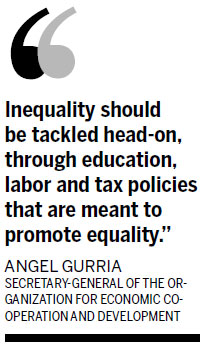OECD report shows mixed trends in income inequality

China's economic inequality has worsened generally in the past two decades but several indicators suggest the trend has halted and is even reversing, according to the latest report from the Organization for Economic Co-operation and Development.
China's Gini coefficient, a gauge of income inequality, was 0.412 in 2000 and many experts believe it has climbed higher since then, indicating a growing wealth gap between rich and poor.
Even so, the OECD report suggests that income inequality is shrinking within urban and rural populations, the wealth gap between the two demographics has narrowed and poorer provinces have started to experience faster economic growth compared with wealthier regions.
The report noted that incomes are increasing faster among the poorest 10 percent of the population. During the 11th Five-Year Plan (2006-10) period, their incomes rose by 10.6 percent a year on average, compared with 9.3 percent seen for the richest 10 percent.
The ratio of average urban to rural incomes, another important indicator of wealth distribution, has declined since 2009.
"By 2009, the ratio had reached 3.3, which is much higher than in other emerging economies such as India," the report said. "Since then, the rural-urban income gap has started to fall and, by 2011, was back to its 2003 level."
The report also cited a study suggesting that income inequality peaked in 2005 and may have reversed in recent years as a result of tax reforms and improvements in the country's welfare system.
The trend comes at a time when wages and household incomes are becoming more unequal among most OECD members, which is composed mostly of developed economies, said Angel Gurria, the organization's secretary-general, at a speech in Beijing on Monday.
"The income of the highest 10 percent in OECD countries now is nine times of that of the lowest 10 percent, whereas 25 years ago the ratio was seven times," Gurria said.
He said the richest 1 percent of the population have accumulated a proportionally greater share of global wealth in recent years, provoking protests "from London to New York, from Tel Aviv to Santiago".
The OECD said that from 2006 to 2011, the amount the Chinese government spent on social programs almost tripled in real terms, rising to nearly 8 percent of the country's GDP. That was a greater proportion compared with Mexico and many other countries but lower than Brazil and Russia.
Gurria said the OECD report shed light on the issue of "inequality", which policymakers across the globe tend to see as being the outcome of economic policies.
"Inequality should be tackled head-on, through education, labor and tax policies that are meant to promote equality," he said.
The report said the incomes made in large Chinese cities do not differ greatly from those found in a number of OECD countries. As a result, such countries' experiences will become increasingly relevant to China.
It called for policies that will help to integrate migrant workers into the labor force and break down barriers that prevent the free flow of labor.
In the meantime, the report said economic growth can be boosted and inequality narrowed by cutting levies that distort the economy and moving from labor and corporate taxes toward consumption taxes.
The report also suggested applying a reduced value-added tax to necessities and raising property and capital taxes.
The suggestions echoed some made in a previous report by the World Bank and the Development Research Center of the State Council.
zhengyangpeng@chinadaily.com.cn


















